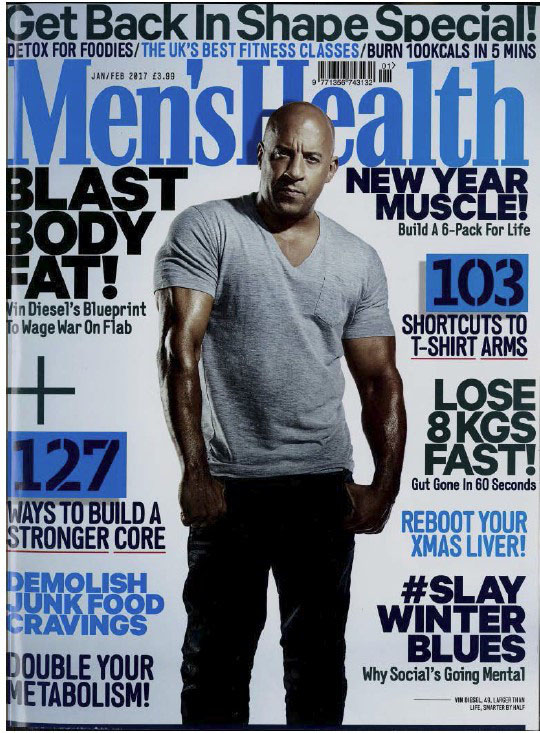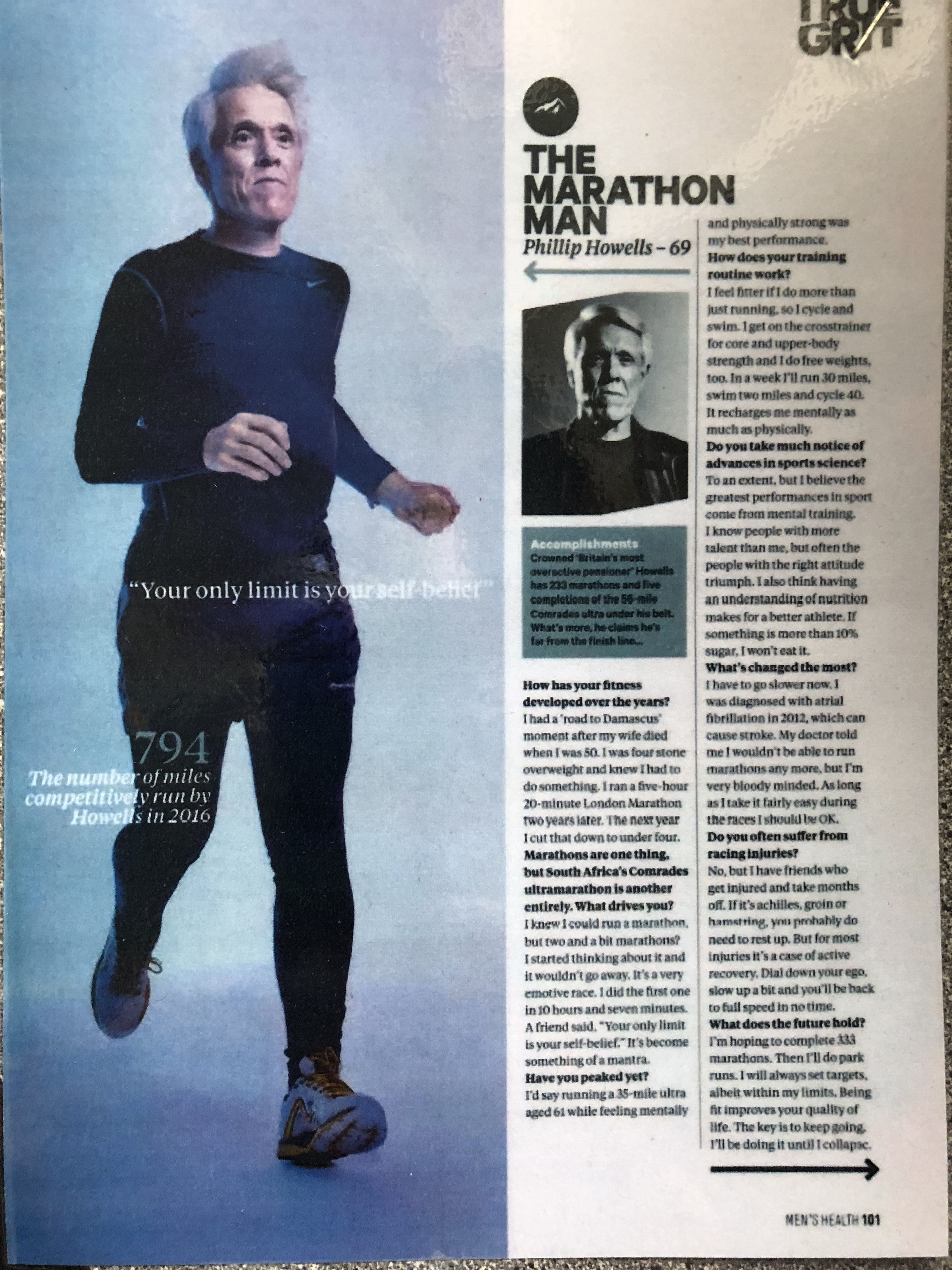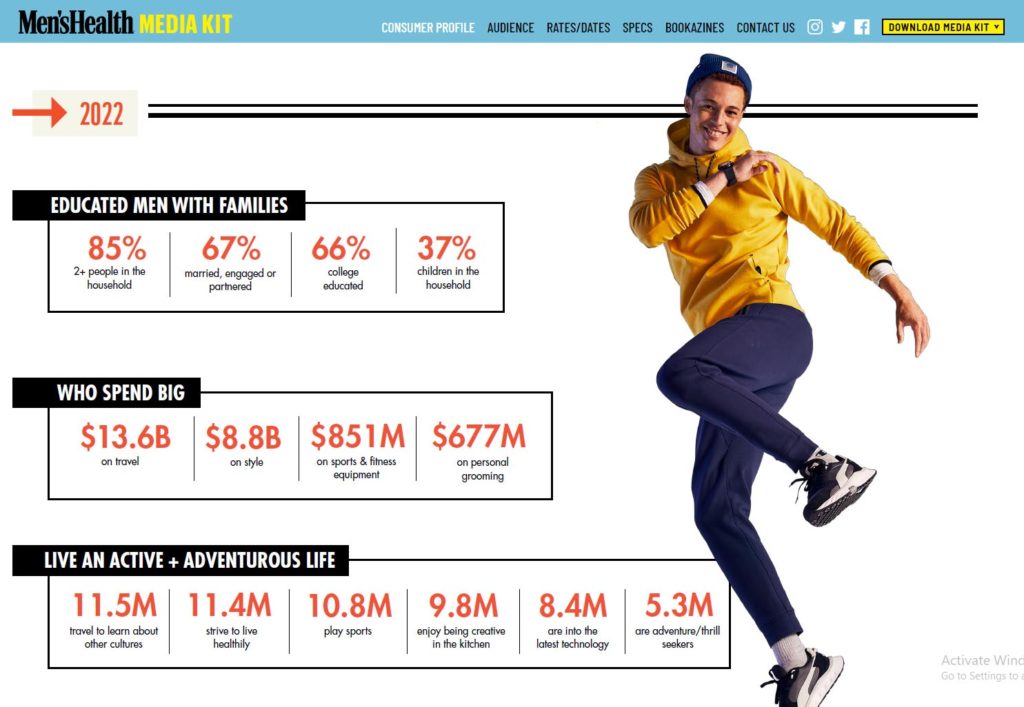




The front magazine page suggest that the anchorage which is the picture of the male figure is linked with the header as it means ‘MENS HEALTH’ a way to which help the male audience to tag along and read more on how to look like the front male figure on the page.
–
Semiotics
Representation – straight ‘alpha male’ men is reactionary. reinforces the idea that men need to be powerful and strong.
– Media language
“get back in shape special” Use of capital letters, exclamation points, colours blue and black stereotypically appealing to men, dialogue “true grit” of men’s wants and desires for their body – all are signifiers to men.
“Best fitness classes for men” – target audience is undoubtedly is for men.
”103 shortcuts to tee shirt arms”, this is a male ‘want’ to aspire to look like Vin Diesel, as his body type is typically what a dream body for a man is, alike skinny arms and a slim waist for women.
Steve Neal says that audience targeting that genres create an appeal for specific audience segments for example to attract the male audience they want something to be portrayed to make them seem powerful and strong to make all of their masculine traits come out.
onimatopia and alliteration.
David g- 4 personality types
- constructed identity- words such as ”muscle, smash, demolish”, construct a typical male identity.
The school of life… thus supporting gauntlets notion of fluid, negotiated, constructive identity.
For example, on page 24 it displays a man topless doing exercise, he is seamlessly lifting weights without any struggle which a ‘warm man’ would display.
key facts on men’s health:
- circulation analysis:
- Joined ABC: 12 April 1995
- Owner: Hearst UK
- ABC Status: Registered
- Reporting Frequency: 12 Monthly (Jan to Dec)
- Standards: Consumer Magazines
- Area: Men’s Lifestyle: General
- 27,871 bought copies in one year
- 66,428 subscription copies in one year
- 1,174 free copies in one year
- 23,077 digital copies bought in one year
Hearst company (parent company) is a conglomerate- owns company’s such as:
–Hearst owns newspapers, magazines, television channels, and television stations, including the San Francisco Chronicle, the Houston Chronicle, Cosmopolitan and Esquire
-Men’s health
-ELLE
-country living
-cosmopolitan
-women’s health
-runners world
– Monthly reach of Men’s Health magazine in the United Kingdom from April 2019 to March 2020, by demographic group.
15+ –1,819
Men- 708
women- 365
adults 15-34- 519
adults 35+ –554
households with children- 391
- Men’s Health magazine had an average monthly reach of around 1.8 million individuals in the United Kingdom from April 2019 to March 2020. Reach was lower among households with children, with 391 thousand readers from this demographic reached by the print title or its website during this period.
To feature in Men’s health:
full page- $205,065 dollars
2/3 page- $159,995
1/2 page- $127,145
1/3 page-$88,180
second cover- $246.080
third cover- $237,880
fourth cover- $268,640
Laswell’s model
–who(sender)
-Hearst communications (parent company)
-Morgan Rees
-says what(message)
-media pack (unique strategies men’s health use to get people to buy and read)
-”professional men to get control of their mental and physical lives”
-Channel(medium)
-online (web portal)
-social media
-To whom(receiver)
-men interested in fitness and health
-Educated men
-family men
-college educated
–With What Effect.
-Making people more healthy
-more happy men in the country
key facts for exam:
dominant signifier – Vin diesel on the front cover of the magazine
dominant ideology – Body image
reactionary representation – A heterosexual man and what society expects on him.
negative stereotype – this creates a negative stereotype to men having to be seen as strong and loose weight
The blue background is associated with male stereotypes, a traditional boy colour
Laswell’s module:
Sender – Men’s health’s is one of the largest men’s magazine and is aimed mainly at “manly” men
Says What – The brand of the magazine called ‘Men’s Health’ aimed for active men who want a better control on their physique / appearance to impress society.
What Channel – Men’s health is a print lifestyle magazine and can also be accessed on their website and social media.
To Whom – Aimed at men who are ‘sporty’ or active. If a man wants motivation to get into shape then the magazine provides information on loosing weight to get that ‘perfect body’
What Effect – Selling the magazine to their target audience through shops, website or social media.
CS Peirce:
Iconic sign – The bold text tells you what you can find inside of this magazine issue. It all relates to loosing weight fast.
Indexical signs – The only image is the dominant signifier placed right in the middle. The muscles relates to the text and the magazine.
Symbolic sign – The magazines colour theme is mostly blue which is seen as a stereotypical colour for men, influences them to buy the magazine. Big bold texts all about loosing weight “demolish junk food cravings” and “Blast body fat”. The dominant signifier, vin diesel, is positioned in the middle showing off his muscles.
Stuart hall – Hall provides a framework for decoding messages:
accept the dominant message
negotiate the dominant message
reject the dominant message
Facts:
- Men’s health magazine had an average monthly reach of around 1.8 million individuals in the UK between 2019 to 2020
- The ages of people who buy this magazine between 2019 to 2020 were 15 years and above and could potentially be harmful for young teenagers because they feel this is how they should look like and that the magazine would help them with their goal to looking muscular.
- The media chooses how people should look like. By adding a celebrity to the front page of their magazine it influences young people to buy and read it.
– Mens health is owned by hearst who own 40 different companies founded in 1887.
what needs to be in the exam-
mainstreaming- guerbner said amount of company’s make the same products – feeding us the same info conglomerates0- concentration of owner ship.
Industry– Hearts communications (conglomerate), concentration of ownership (eg: other mag that heart owns), hesmandhale (risky buisness), cross media platforms( digital and print), role and prominence of advertising, profit, income, sales, online data.
Language– Use of colour, font, layout, image, semantic fields(words used), juxtaposition, semiotics, genre, narrative
Representation– reactionary and radical, stereotype, counter type, collective identity, negotiated identity (ie: guentlt,) mulvey (male gaze), Butler (gender performance)
Audience-
Stuart hall (preferred reading) guerdner (cultivation theory, mainstreaming), lazerfeld( 2 step slow, opinion leader, audience profile\demographics-see men’s health media profile, psychographic profile- all ages)
–
